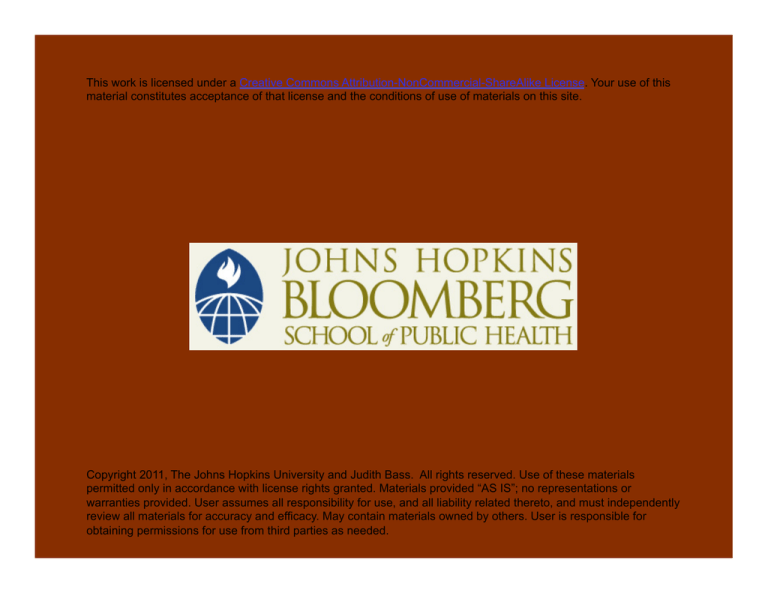
This work is licensed under a Creative Commons Attribution-NonCommercial-ShareAlike License. Your use of this
material constitutes acceptance of that license and the conditions of use of materials on this site.
Copyright 2011, The Johns Hopkins University and Judith Bass. All rights reserved. Use of these materials
permitted only in accordance with license rights granted. Materials provided “AS IS”; no representations or
warranties provided. User assumes all responsibility for use, and all liability related thereto, and must independently
review all materials for accuracy and efficacy. May contain materials owned by others. User is responsible for
obtaining permissions for use from third parties as needed.
Section B
Instrument Validation
Measurement Validity
Definition
- The extent to which a test measures what it purports to
measure
Goal
- Diagnostic systems that accurately summarize signs and
symptoms to indicate etiology and suggest prevention,
prognosis, and treatment
3
Problems with Relying on Standard (Western) Measures
Cultural validity
- How closely concepts in a questionnaire match local concepts;
Western/outside concepts may not apply locally
Unknown local concepts
- Are there important local issues/concepts unknown to us? How
to include questions we don’t know we should be asking?
Translation problems
- Who translates? Translation/back-translation methods
inadequate, can result in semantic equivalence but real-world
insignificance (e.g., “lighting fires”)
RISK: Evaluations don’t accurately measure impact
4
Types of Validity
Weak
Face validity
Content validity
Construct validity
Strong
Criterion validity
5
Validity
Face validity
- It appears as expected
Content validity
- Covers range of signs and symptoms relevant to syndrome
6
Validity
Face validity
- It appears as expected
Content validity
- Covers range of signs and symptoms relevant to syndrome
Construct validity
- Theory-based—assessing correspondence between items
- Can include cause-and-effect relationships
7
Validity
Face validity
- It appears as expected
Content validity
- Covers range of signs and symptoms relevant to syndrome
Construct validity
- Theory-based—assessing correspondence between items
- Can include cause-and-effect relationships
Criterion validity
-
-
Strength of comparison with external standard
Concurrent/discriminant and predictive
8
Reliability
Consistency between measures of the same thing—a direct function
of the amount of measurement error in a variable
- Consistency across time (test-retest)
- Consistency across assessors (inter-rater)
- Internal consistency of instrument (alpha)
9
Reliability vs. Validity
Consistent measurement vs. information about etiology and
underlying disorder
DSM and ICD: Operational definitions based on consensus and
experience; reliable
10
Utility
Defined by purpose of assessment
- Etiologic research
- Triage
11
Utility
Defined by purpose of assessment
- Etiologic research
- Triage
Categorical vs. dimensional perspectives
12
Validity Challenges
Gold standard diagnostic techniques rare
- Disease process can be well understood, but measurement is
inaccurate
- Disease process can be imperfectly understood, with
controversy as to which signs and symptoms to use even if they
can be measured accurately
13
Cross-Cultural Issues
No gold standard
Can be difficult to define mental illness
Lack of cross-cultural research on consistency in disorder expression
14




